



Image Usage Information
Family: Polygyridae
Common name: Bladetooth Wedge
Discovery: F.C. Baker, 1921
North American native, non-native in Northeast Region
Identification
Width: ~14-18 mm
Height: ~8-10 mm
Whorls: ~5
This shell of Xolotrema fosteri is subglobose, flattened from top to bottom, and has a widely reflected, toothed lip. There is a subtle palatal denticle, a strong basal lamella, and a pronounced “blade”-like parietal denticle. The umbilicus is closed. The shell is sculptured with riblets, approximately 3/mm in the final whorl (Pilsbry, 1940). The live animal is gray.
This shell differs from Patera appressa in lacking papillae on the base. Xolotrema denotata has a larger palatal denticle and a fuzzy coating of bristles on fresh shells.
Ecology
Xolotrema fosteri is found in both natural and anthropogenic habitats. It occurs in leaf litter, among logs and rocks, on “waste ground” and roadsides (Hubricht, 1985). It occurs on slopes, in ravines, and on floodplains.
Taxonomy
Synonyms are Helix appressa and Triodopsis appressa, in part, and Polygyra appressa fosteri (Pilsbry, 1940).
Distribution
Xolotrema fosteri is native to the Mississippi Valley, Central and Southeastern US. It was deliberately introduced into a Burlington, New Jersey garden in the 1860’s and by 1909 was abundant in that area (Pilsbry, 1940). There are museum records from New York to Maryland.
Conservation
NatureServe Rank: G5, Secure.
